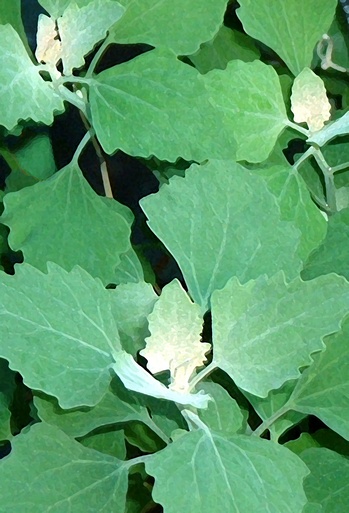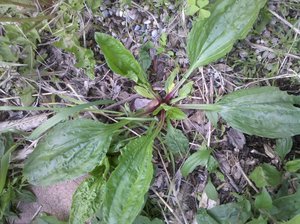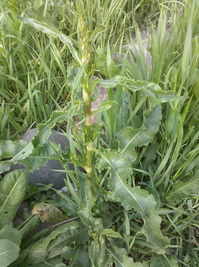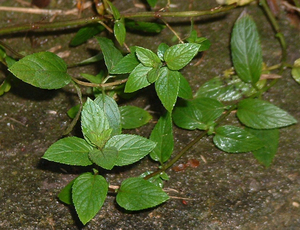Wildcrafting: 10 helpful lawn weeds you can eat and use as health remedies

Lamb's quarters, a calcium rich wonderful edible weed you might find in your lawn or garden.
Linda Diane Feldt | Contributor
If you haven’t had your lawn “improved” through chemical applications, there is a treasure trove of useful plants growing with your grass. Keep reading and it is possible your experience of your lawn will never be the same again.
What are my top 10 valuable local lawn weeds? In no particular order: lamb’s quarters, plantain, purslane, chickweed, mallow, yellow dock, chicory, violet, mint and dandelion. I’ve provided a brief paragraph on each one, and a few links for more information. There are at least a dozen more that deserve to be included, I’ll write about them as the summer goes on.
Lamb’s quarters, Chenopodium, grows in disturbed ground, commonly a flower or vegetable bed. It has a nice rich, mild, slightly chalky taste, is great as a base for salads (I use it in place of lettuce), as a spinach-like topping for sandwiches or can also be lightly steamed. If you blanch it (a few seconds in boiling water) it can be frozen for adding to soups, casseroles, or other dishes all winter long. It’s almost certain that if you are removing this from your vegetable beds to plant something else, the lamb’s quarters is likely more nutritious and easier to grow than whatever you are planting.

Plantain is everywhere, and helpful for cold sores and insect bites as well as being a great addition to salads.
Linda Diane Feldt | Contributor
Plantain, Plantago americana, grows near paths, driveways and especially in areas between the sidewalk and the street. Low to the ground, in a rosette, it is there when you need it. Not only is it a salad green, it is an excellent first aid ally. Crushed or chewed you can use it on insect bites, rashes, scrapes and especially on cold sores and a sore throat. It can help with mild pain relief and is soothing and healing.Â
Because the taste is mild, it’s ideal for mouth sores because you can just place some of the chewed up leaf against the injury and leave it there. I’ve also used it for throat pain associated with radiation and chemotherapy, either chewed or juiced and made into ice cubes.
Purslane, Portulaca olearacea, is so common I’ve found it growing next to many of the parking meters downtown. Given how popular these areas are with dogs, I wouldn’t suggest harvesting from that area, but I have taken home a few pieces to plant in my garden for later eating.
Many people are unaware that this common garden weed is one of the richest sources of omega 3 precursors in the plant kingdom. It has a benign taste, and the fat, succulent-like leaves are easy to add to salads or as a garnish to other foods. Not available in stores, it is enjoyed in season fresh from the garden as long as it is actively growing. One hundred grams of fresh purslane leaves (one serving) contain about 300-400 mg of 18:3w3;Â 12.2 mg of alpha-tocopherol; 26.6 mg of ascorbic acid; 1.9 mg of beta-carotene; and 14.8 mg of glutathione. Yes, this simple weed is packed with nutritional benefits. I’ve written about purslane and how it can help with inflammation in a previously published article.
Chickweed, Stellaria media, is a tiny little plant that is sort of viney in the way it crawls around your yard. The flowers are also small and pretty. The whole plant can be eaten, and is tasty in salads. Used topically, the crushed leaves can help cool wounds, decrease swelling and of special note it seems to help many people with skin problems including eczema and psoriasis.
Mallow, Malva neglecta, is edible in many forms: the leaves, the flowers and the cheese-like (as in a wheel of cheese) fruits. Slightly slimy, (call it mucilaginous if you don’t want to turn people off) it adds texture and mild almost chalky taste to salads. Kids especially enjoy popping off the fruits and eating them.

Yellow dock, or curly dock, grows where there is iron in the soil. It makes a fabulous and easy pesto.
Linda Diane Feldt | Contributor
Yellow dock, Rumex crispus, remains one of my all-time favorites. The leaves come up early in the spring and I can make pesto from the long curly leaves in April and sometimes earlier. They are great in salads, or cooked with other greens. I’ve made an herbal oil from the root that has helped remarkably with tissue healing, especially with trauma. It hastens healing, decreases pain and minimizes bruising. There are no studies or reports on the herb used this way, but it has a growing following based on anecdotal experience. The leaves are high in iron content, the root is tinctured and used to increase iron absorption in addition to many other uses.
Chicory, Cichorium intybus, is commonly mistaken for dandelion until it produces the lovely pale blue flowers. While the leaves can be eaten (chicory has a hairy midrib, dandelion is smooth) the flowers are also edible, and the root can be dug up, roasted in a slow (200 degree) oven for a couple hours, and then ground to use like coffee.
Violet, Viola, has edible leaves and flowers, is a pretty plant in the early spring, and the leaves are used in herbal medicine for reducing some types of tumors.
Mint is everywhere and there are so many different kinds. Some start off tame, some appear wild. Mentha piperita is chocolate mint, one of my favorites. Nepeta cataria is common catnip. These can all be used as teas or to cook with. Just tonight I had some tabouli made with chocolate mint and some other wild mint. Catnip and other mints are known for soothing the stomach; I used peppermint for post-surgical nausea recently. It was amazing. I brought some essential oil of peppermint to the hospital with me, and in the recovery room had a friend place a few drops on a piece of gauze. Every time I felt a little nausea come on I took a sniff and immediately felt better.

Chocolate mint can escape into you lawn. It smells even better than it tastes.
Linda Diane Feldt | Contributor
Catnip is also being used as a natural insect repellent. Made into an oil or a tincture (an alcohol based preparation), it works really well to keep mosquitoes at bay. I tend to need to reapply it every half hour or so, but as a natural method it is very effective. As a last minute help, I have been known to go into the woods with catnip stems and leaves braided into my hair, or hanging from a hat. I just crush it a bit to keep it active. It works surprisingly well.
I’ve written a lot about dandelion already. You can read about it by clicking here.
Imagine, all of that is in your lawn - that is if you’re lucky. How did we ever get to be so complacent that we let all of this knowledge of food and herbal medicine slip from our memory and common use, as well as the plants themselves? With greater awareness of the value of local food, understanding that we need to cut our chemical consumption, and with more people interested in do-it-yourself ideas, this is a great time to stop killing the helpful plants that grow out our back (and front) doors and begin to eat them instead.
Linda Diane Feldt is a local Holistic Health Practitioner, Herbalist, writer and teacher. You can follow her on twitter, or look for her website. A partly completed compilation of all of her AnnArbor.com blogs is online. Linda Diane has three weed walks scheduled for May and June, contact her ldfeldt(at)holisticwisdom.org for more information. If you are interested in local herbs that can be use medicinally, she is offering a free class through The People’s Food Co-op on May 27 on that subject. The class will be held 7-8:30 pm at Crazy Wisdom Bookstore.


Comments
Linda Diane Feldt
Mon, May 17, 2010 : 11:11 a.m.
I just posted the handout for the upcoming weed walks. You can find it here, http://www.holisticwisdom.org/hwpages/herbwisdsyll.htm just click on the first article for a PDF file. That has over 30 plants with brief descriptions. Hope that helps expand your interest.
AlphaAlpha
Sun, May 16, 2010 : 8:29 p.m.
Excellent article Linda, though much too short. Please do expand this timely concept. It would also be great to cover edible landscaping. Thank you very much.
Linda Diane Feldt
Thu, May 13, 2010 : 8:04 a.m.
Regarding toxins. The areas to clearly avoid are near railroad tracks and high tension wires. These areas are may be regularly and extensively sprayed. And even if they haven't been for a while, they suddenly could be. Since lead was eliminated from gas, areas near roads are much safer. Generally (but not always) if the plant looks healthy and vibrant that is a good indicator. But the best bet is to know the area, who sprays and who doesn't, and be cautious. I don't like heavily trafficked areas, I now know dog behavior enough to avoid areas they would use. But you do have to look for clues. This is one reason your own lawn can be a great resource - you have so much more control and knowledge about what is going on there.
Al Feldt
Wed, May 12, 2010 : 8:21 a.m.
Great article, Linda. Though I have heard of several of these before, this stimulates me to go out and pull some additions to my salads. Lettuces from Doles gets boring after a while. Violets and plantain tonight!
Guinea Pig in a Tophat
Wed, May 12, 2010 : 7:32 a.m.
How interesting! I'd like to try some of theses plants. Would you happen to know if there is any worry with toxins in weeds near parking lots, busy roads, etc.?